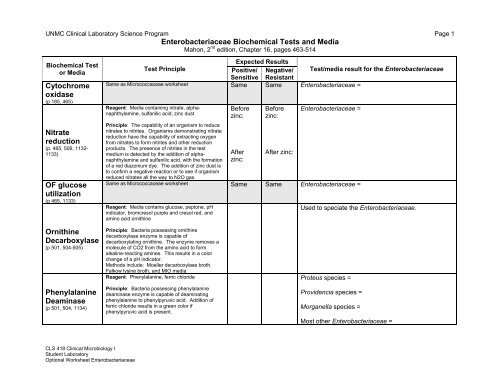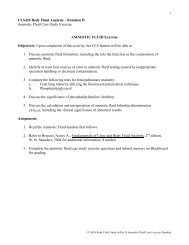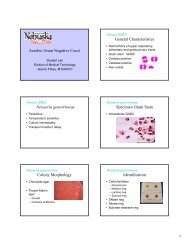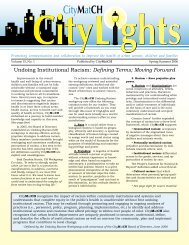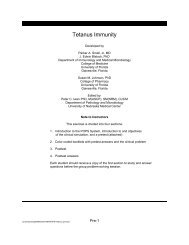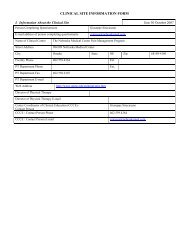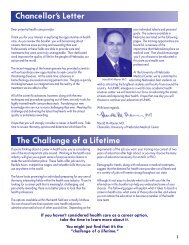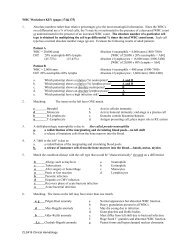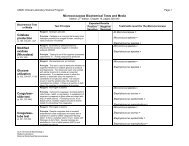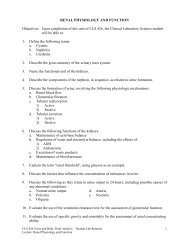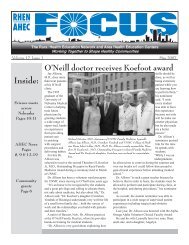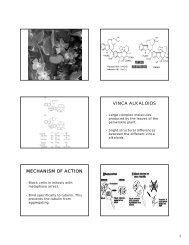Micrococcaceae Biochemical Tests and Media - UNMC
Micrococcaceae Biochemical Tests and Media - UNMC
Micrococcaceae Biochemical Tests and Media - UNMC
You also want an ePaper? Increase the reach of your titles
YUMPU automatically turns print PDFs into web optimized ePapers that Google loves.
<strong>UNMC</strong> Clinical Laboratory Science Program Page 1Enterobacteriaceae <strong>Biochemical</strong> <strong>Tests</strong> <strong>and</strong> <strong>Media</strong>Mahon, 2 nd edition, Chapter 16, pages 463-514<strong>Biochemical</strong> Testor <strong>Media</strong>Cytochromeoxidase(p 185, 465)Nitratereduction(p. 465, 506, 1132-1133)OF glucoseutilization(p 465, 1133)Expected ResultsTest PrinciplePositive/ Negative/ Test/media result for the EnterobacteriaceaeSensitive ResistantSame as <strong>Micrococcaceae</strong> worksheet Same Same Enterobacteriaceae =Reagent: <strong>Media</strong> containing nitrate, alphanaphthylamine,sulfanilic acid, zinc dustPrinciple: The capability of an organism to reducenitrates to nitrites. Organisms demonstrating nitratereduction have the capability of extracting oxygenfrom nitrates to form nitrites <strong>and</strong> other reductionproducts. The presence of nitrites in the testmedium is detected by the addition of alphanaphthylamine<strong>and</strong> sulfanilic acid, with the formationof a red diazonium dye. The addition of zinc dust isto confirm a negative reaction or to see if organismreduced nitrates all the way to N2O gas.Beforezinc:Afterzinc:Beforezinc:After zinc:Enterobacteriaceae =Same as <strong>Micrococcaceae</strong> worksheet Same Same Enterobacteriaceae =Reagent: <strong>Media</strong> contains glucose, peptone, pHindicator, bromcresol purple <strong>and</strong> cresol red, <strong>and</strong>amino acid ornithineUsed to speciate the Enterobacteriaceae.OrnithineDecarboxylase(p 501, 504-505)PhenylalanineDeaminase(p 501, 504, 1134)Principle: Bacteria possessing ornithinedecarboxylase enzyme is capable ofdecarboxylating ornithine. The enzyme removes amolecule of CO2 from the amino acid to formalkaline-reacting amines. This results in a colorchange of a pH indicator.Methods include: Moeller decarboxylase broth,Falkow lysine broth, <strong>and</strong> MIO mediaReagent: Phenylalanine, ferric chloridePrinciple: Bacteria possessing phenylalaninedeaminase enzyme is capable of deaminatingphenylalanine to phenylpyruvic acid. Addition offerric chloride results in a green color ifphenylpyruvic acid is present.Proteus species =Providencia species =Morganella species =Most other Enterobacteriaceae =CLS 418 Clinical Microbiology IStudent LaboratoryOptional Worksheet Enterobacteriaceae
<strong>UNMC</strong> Clinical Laboratory Science Program Page 2Enterobacteriaceae <strong>Biochemical</strong> <strong>Tests</strong> <strong>and</strong> <strong>Media</strong>Mahon, 2 nd edition, Chapter 16, pages 463-514<strong>Biochemical</strong> Testor <strong>Media</strong>Indoleproduction(p 185, 467, 501-502,505)Citrateutilization(p 467, 501-502, 1122)Gelatinliquefaction(p: 492-495, 1126)Motility(p 465, 501, 505, 1131-1132)Test PrincipleReagent: Amino acid tryptophan in broth,para-dimethylaminobenzaldehydePrinciple: Bacteria that possess the enzymetryptophanase are capable of cleaving tryptophan,producing indole, pyruvic acid <strong>and</strong> ammonia.Indole can be detected by adding paradimethylaminobenzalde-hyde(Ehrlich’s orKovac’s reagent) <strong>and</strong> observing a red color.Reagent: Sodium citrate, pH indicatorPrinciple: This test is determines the ability of anorganism to utilize sodium citrate as its onlycarbon source for metabolism. Bacteria that cangrow on this medium turn the bromthymol blueindicator from green to blue.Reagent: GelatinPrinciple: This test is used to determine theability of an organism to produce proteolyticenzymes (gelatinases) that liquefy gelatin.Reagent:
<strong>UNMC</strong> Clinical Laboratory Science Program Page 3Enterobacteriaceae <strong>Biochemical</strong> <strong>Tests</strong> <strong>and</strong> <strong>Media</strong>Mahon, 2 nd edition, Chapter 16, pages 463-514<strong>Biochemical</strong> Testor <strong>Media</strong>Voges-Proskauer(Acetylmethylcarbinol)(p 198, 467, 498, 500-501, 1131)Test PrincipleReagent: Potassium hydroxide, alpha-naphtholPrinciple: This test is used to determine theability of an organism to metabolize glucose topyruvic acid, then to acetyl-methyl-carbinol(acetoin). In the presence of atmospheric oxygen<strong>and</strong> 40% KOH, acetoin is converted to diacetyl,<strong>and</strong> then alpha-naphthol is added to catalyze orbring out a red complex.Reagent: UreaExpected ResultsPositive/ Negative/Sensitive ResistantTest/media result for the EnterobacteriaceaeUsed to speciate the Enterobacteriaceae.Used to speciate the Enterobacteriaceae.Ureaseproduction(p 185, 467, 501, 503,1139)KIA(p. 497-499, 1127-1128)Principle: Urease is an enzyme possessed bymany species of microorganisms that canhydrolyze urea to ammonia, CO2 <strong>and</strong> H2O. Theammonia reacts in solution to form ammoniumcarbonate, resulting in alkalinization <strong>and</strong> anincrease in the pH of the medium. The pHchange will cause the phenol red indicator tochange to red.Ingredients: Medium in tube as a slant containsagar base, dextrose, lactose (10x concentration ofdextrose), phenol red <strong>and</strong> ferrous sulfate.Medium is red uninoculated.Principle: This test is used to determine theability of an organism to ferment glucose <strong>and</strong>lactose <strong>and</strong> produce hydrogen sulfide.Fermentation of glucose but not lactose, changesthe color from red to yellow (butt <strong>and</strong> slant)initially. With continued incubation, slant changesback to red due to reversion of reaction underaerobic conditions. Butt remains yellow due toanaerobic conditions. Fermentation of bothglucose <strong>and</strong> lactose changes color from red toyellow, <strong>and</strong> both butt <strong>and</strong> slant stay yellow due tohigh levels of lactose being fermented. Blackprecipitate forms when organism is able toproduce H2S from ferrous sulfate.A/A =K/K =K/A =Black precipitate =Gas =Examples of Enterobacteriaceae that are lactosefermenters:Examples of Enterobacteriaceae that are non-lactosefermenters:CLS 418 Clinical Microbiology IStudent LaboratoryOptional Worksheet Enterobacteriaceae
<strong>UNMC</strong> Clinical Laboratory Science Program Page 4Enterobacteriaceae <strong>Biochemical</strong> <strong>Tests</strong> <strong>and</strong> <strong>Media</strong>Mahon, 2 nd edition, Chapter 16, pages 463-514<strong>Biochemical</strong> Testor <strong>Media</strong>TSI(p 497-499, 1138)Test PrincipleIngredients: Medium in tube as a slant containsagar base, dextrose, lactose <strong>and</strong> sucrose (both 10xconcentration of dextrose), phenol red <strong>and</strong> ferroussulfate. Medium is red uninoculated.Principle: This test is used to determine the abilityof an organism to ferment glucose, lactose, <strong>and</strong>/orsucrose, <strong>and</strong> produce hydrogen sulfide.Fermentation of dextrose but no lactose or sucrose,changes the color from red to yellow (butt <strong>and</strong> slant)initially. With continued incubation, slant changesback to red due to reversion of reaction underaerobic conditions. Butt remains yellow due toanaerobic conditions.Fermentation of dextrose plus lactose <strong>and</strong>/orsucrose changes color from red to yellow, <strong>and</strong> bothbutt <strong>and</strong> slant stay yellow due to high levels oflactose being fermented. Black precipitate formswhen organism is able to produce H2S from ferroussulfate.Ingredients: Medium in tube as a slant containsagar base, lysine, small amount of glucose, ferricammonium citrate, sodium thiosulfate <strong>and</strong>bromcresol purple (pH indicator). Medium is purpleuninoculated.Expected ResultsPositive/ Negative/Sensitive ResistantA/A =K/K =K/A =Black precipitate =Gas =LDA =LDA =Test/media result for the EnterobacteriaceaeUsed to speciate the Enterobacteriaceae.Organism LDA LDC H2SProteus speciesLIA(p 505, 1129)Principle: This test is used to determine whether aGNR decarboxylates or deaminates lysine <strong>and</strong>forms hydrogen sulfide. Butt: Glucose fermentation(acidic) will turn butt yellow. If the organismproduces lysine decarboxylase, cadaverine isformed. Cadaverine neutralizes the organism acidsformed by glucose fermentation, <strong>and</strong> the butt revertsto alkaline state (purple). If decarboxylase is notproduced, butt remains acidic (yellow). Slant: If theoxidative deamination of lysine occurs, a compoundis formed that, in the presence of ferric ammoniumcitrate <strong>and</strong> a coenzyme, flavin mononucleotide,forms a burgundy (wine-red) color on the slant. Ifdeamination does not occur, the LIA slant remainspurple. Black precipitate = H2S production fromferric ammonium citrate.LDC =H2S =LDC =H2S =Providencia speciesSalmonella speciesCitrobacter speciesCLS 418 Clinical Microbiology IStudent LaboratoryOptional Worksheet Enterobacteriaceae
<strong>UNMC</strong> Clinical Laboratory Science Program Page 5Enterobacteriaceae <strong>Biochemical</strong> <strong>Tests</strong> <strong>and</strong> <strong>Media</strong>Mahon, 2 nd edition, Chapter 16, pages 463-514<strong>Biochemical</strong> Testor <strong>Media</strong>Test Principle<strong>Media</strong> classification: Selective <strong>and</strong> differential forGNRExpected ResultsPositive/ Negative/Sensitive ResistantTest/media result for the EnterobacteriaceaeExamples of Enterobacteriaceae that are lactosefermenters:MacConkeyagar(p 314-316, 490-491,964, 1129-1130)Ingredients: Peptone base with lactose, grampositive organisms inhibited by crystal violet <strong>and</strong> bilesalts. Neutral red as indicator.Principle: pH indicator changes to dark pink/redwhen organism ferments lactose. Non-lactosefermenters remain clear <strong>and</strong> colorless.Examples of Enterobacteriaceae that are non-lactosefermenters:<strong>Media</strong> classification: Selective <strong>and</strong> differential forGNR – esp. Salmonella <strong>and</strong> ShigellaColony morphology:Hektoenenteric agar(HE)(p 490-491, 964, 1126-1127)Ingredients: Peptone base agar with bile salts,lactose, sucrose, salicin, <strong>and</strong> ferric ammoniumcitrate. Indicators include bromthymol blue <strong>and</strong> acidfuchsin.Principle: Gram positive organisms <strong>and</strong> somecoliforms are inhibited by high bile saltconcentration. GNR that will grow can bedifferentiated as to lactose/sucrose fermenters / nonfermenters.H2S production can also bedetermined.<strong>Media</strong> classification: Differential, selective mediumfor the isolation <strong>and</strong> differentiation of Salmonella <strong>and</strong>Shigella spp. from other gram negative entericbacilli.E. coli =Salmonella =Shigella =Colony morphology:E. coli =Xylose lysinedesoxycholateagar (XLD)(p 490-491, 964, 1139-1140)Ingredients: Yeast extract agar with lysine, xylose,lactose, sucrose, <strong>and</strong> ferric ammonium citrate.Sodium desoxycholate inhibits gram positiveorganisms; phenol red as indicator.Principle: Sucrose, lactose <strong>and</strong> xylose can befermented. Lysine can be decarboxylated. Sodiumthiosulfate can be used for production of H2S.Salmonella =Shigella =Citrobacter =CLS 418 Clinical Microbiology IStudent LaboratoryOptional Worksheet Enterobacteriaceae


